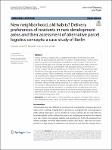Item Infomation
Full metadata record
| DC Field | Value | Language |
|---|---|---|
| dc.contributor.author | Johannes, Gruber | - |
| dc.contributor.author | Benjamin, Heldt | - |
| dc.contributor.author | Saskia, Seidel | - |
| dc.date.accessioned | 2023-04-13T04:10:40Z | - |
| dc.date.available | 2023-04-13T04:10:40Z | - |
| dc.date.issued | 2023 | - |
| dc.identifier.uri | https://link.springer.com/article/10.1186/s41072-023-00138-9 | - |
| dc.identifier.uri | https://dlib.phenikaa-uni.edu.vn/handle/PNK/7889 | - |
| dc.description | CC BY | vi |
| dc.description.abstract | Various alternative solutions for sustainable last-mile parcel deliveries have been piloted and partially put into operation in Europe in the past decade. However, these delivery concepts have mainly been considered in inner-city areas. There are a few examples of the application of these concepts in peripheral urban areas, where new housing is being built to accommodate high population pressure. However, it is unclear whether the delivery preferences of residents in new neighbourhoods differ from those of the population average. This research conducted a case study in the western outskirts of Berlin, examining two newly built neighbourhoods and one existing residential area. | vi |
| dc.language.iso | en | vi |
| dc.publisher | Springer | vi |
| dc.subject | Delivery preferences | vi |
| dc.subject | alternative parcel logistics concepts | vi |
| dc.title | New neighborhood, old habits? Delivery preferences of residents in new development areas and their assessment of alternative parcel logistics concepts: a case study of Berlin | vi |
| dc.type | Book | vi |
| Appears in Collections | ||
| OER - Kinh tế và Quản lý | ||
Files in This Item:

